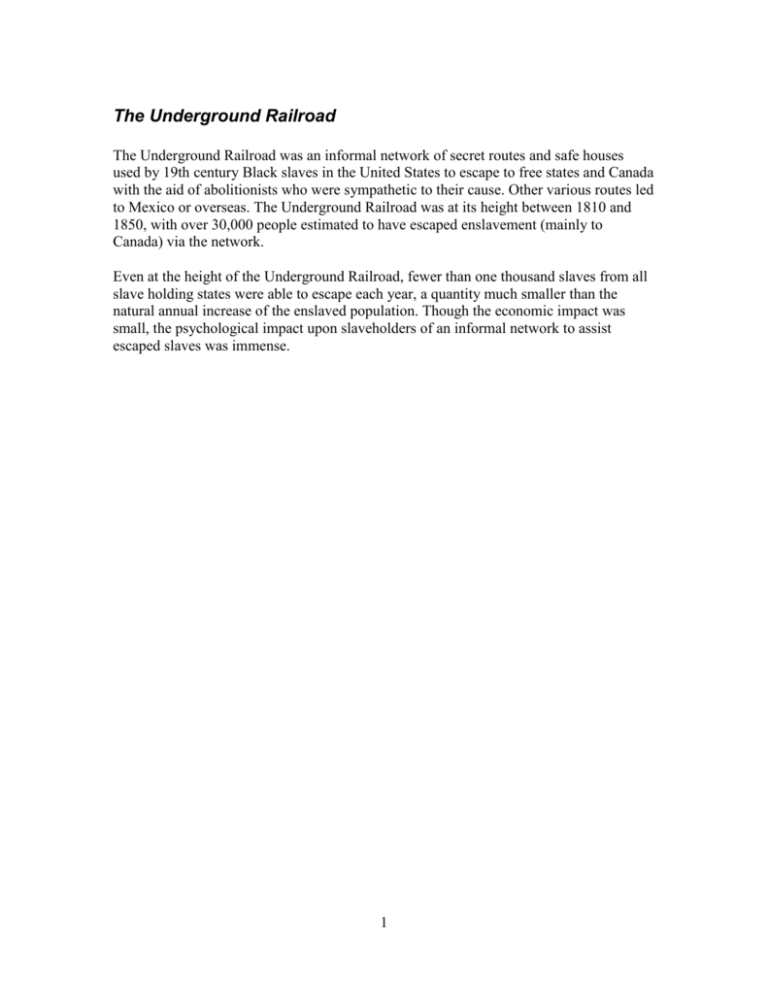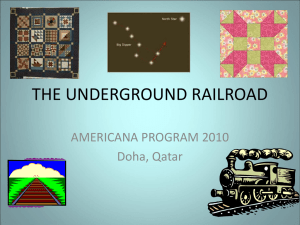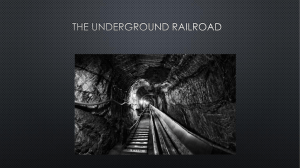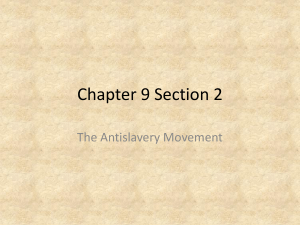Readings - CSA History Rocks
advertisement

The Underground Railroad The Underground Railroad was an informal network of secret routes and safe houses used by 19th century Black slaves in the United States to escape to free states and Canada with the aid of abolitionists who were sympathetic to their cause. Other various routes led to Mexico or overseas. The Underground Railroad was at its height between 1810 and 1850, with over 30,000 people estimated to have escaped enslavement (mainly to Canada) via the network. Even at the height of the Underground Railroad, fewer than one thousand slaves from all slave holding states were able to escape each year, a quantity much smaller than the natural annual increase of the enslaved population. Though the economic impact was small, the psychological impact upon slaveholders of an informal network to assist escaped slaves was immense. 1 Vocabulary Members of The Underground Railroad often used specific vocabulary, based on the metaphor of the railway. For example: * People who helped slaves find the railroad were "agents" (or "shepherds") * Guides were known as "conductors" * Hiding places were "stations" * Abolitionists would fix the "tracks" * "Stationmasters" hid slaves in their homes * Escaped slaves were referred to as "passengers" or "cargo" * Slaves would obtain a "ticket" * Just as in common gospel lore, the "wheels would keep on turning" * Financial benefactors of the Railroad were known as "stockholders". * The Railroad itself was often known as the "freedom train" or "Gospel train". * Escapees were headed towards “Heaven” or “The Promised Land” - Canada 2 Vigilance Committees The fugitives would sometimes travel by train and boat -- transports that sometimes had to be paid for. Money was also needed to improve the appearance of the runaways -- a black man, woman, or child in tattered clothes would invariably attract suspicious eyes. This money was donated by individuals and also raised by various groups, including vigilance committees. Vigilance committees sprang up in the larger towns and cities of the North, most prominently in New York, Philadelphia, and Boston. In addition to soliciting money, the organizations worked together with local abolition societies, African American churches and a variety of individuals to help fugitives move further on or to find them homes and work. Vigilance committees also watched out vigilantly for the rights of northern free blacks. The Underground Railroad had many notable participants, including John Fairfield in Ohio, the son of a slaveholding family, who made many daring rescues, Levi Coffin, a Quaker who assisted more than 3,000 slaves, and Harriet Tubman, who made 19 trips into the South and escorted over 300 slaves to freedom. 3 Organization The escape network was solely "underground" in the sense of being an underground resistance (a group of people working together against slavery in secret). The network was known as a "railroad" by way of the use of rail terminology in the code. The Underground Railroad consisted of meeting points, secret routes, transportation, and safe houses, and assistance provided by abolitionist sympathizers. Individuals were often organized in small, independent groups, which helped to maintain secrecy since some knew of connecting "stations" along their route, but knew few details outside of their immediate area. It ensured that if one section was discovered, the entire system was not in jeopardy. Escaped slaves would move along the route from one way station to the next, steadily making their way north. "Conductors" on the railroad came from various backgrounds and included free-born blacks, white abolitionists, former slaves (either escaped or manumitted (freed)), and Native Americans. Churches also often played a role, especially the Religious Society of Friends (Quakers), Congregationalists, Wesleyans, and Reformed Presbyterians as well as certain sects of mainstream denominations such as branches of the Methodist church and American Baptists. 4 Routes Many people associated with the Underground Railroad only knew their part of the operation and not of the whole scheme. This was to protect the secrets of the railroad and evade detection. Though this may seem like an unreliable route for slaves to gain their freedom, hundreds of slaves obtained freedom to the North every year. The resting spots where the runaways could sleep and eat were given the code names “stations” and “depots” which were held by “station masters”. There were also those known as “stockholders” who gave money or supplies for assistance. There were the “conductors” who ultimately moved the runaways from station to station. The “conductor” would sometimes act as if he or she were a slave and enter a plantation. Once a part of a plantation the "conductor" would direct the fugitives to the North. During the night the slaves would move, traveling on about 10–20 miles (15–30 km) per night. They would stop at the so-called “stations” or "depots" during the day and rest. While resting at one station, a message was sent to the next station to let the station master know the runaways were on their way. Sometimes boats or trains would be used for transportation. Money was donated by many people to help buy tickets and even clothing for the fugitives so they would remain unnoticeable. Soon after the railroad had freed 300 slaves, some of the freed slaves made a store for the railroad. 5 Traveling the Underground Railroad Although the fugitives sometimes traveled on real railways, the primary means of transportation were on foot or by wagon. In addition, routes were often purposely indirect in order to throw off pursuers. Most escapes were by individuals or small groups; occasionally, such as with the Pearl incident, there were mass escapes. The majority of the escapees were young bondmen, usually artisans from Border States who believed their skills gave them a chance of survival in the North. The journey was often seen as too arduous and treacherous for women or children to complete. Many fugitive bondmen, however, who escaped via the Railroad and established livelihoods as free men, later purchased their wives, children, and other family members out of slavery. Because of this, the number of former slaves who owed their freedom at least in part to the courage and determination of those who operated the Underground Railroad was greater than the many thousands who actually traveled its secret routes. 6 Fugitive Slave Laws With the Fugitive Slave Law of 1793, the responsibility for catching runaway slaves fell to officials of the states from where the slaves came, and the Underground Railroad thrived. With heavy political lobbying, the Compromise of 1850, passed by Congress after the Mexican-American War, stipulated a more stringent Fugitive Slave Law. The law pressured officials of free states to assist slave catchers if there were runaway slaves in the area, and granted slave catchers permission when in free states to do their job. Additionally, free blacks of the North could easily be forced into slavery, whether they had been freed earlier or had never been slaves. Suspected slaves were unable to defend themselves in court, and it was difficult to prove a free status. Judges were bribed more ($10) for a decision that forced a suspected slave back into slavery than ($5) for a decision that the suspected slave was in fact free. Thus, many Northerners who would have otherwise been able and happy to ignore far-away regional slavery were now forced to face the issue of slave catchers active in their hometown. It changed everything. As a result, runaway slaves couldn’t simply cross the Ohio River into freedom, they now had to make their ways to Canada to truly find refuge. Any person aiding a runaway slave by providing shelter, food or any other form of assistance was liable to six months' imprisonment and a $1,000 fine. Those officers capturing a fugitive slave were entitled to a fee and this encouraged some officers to kidnap free Negroes and sell them to slave-owners. 7 Slave Catchers Slave catchers were the people who returned escaped slaves to their owners in the United States in the mid-19th century. It is well documented that both slave owners and slave catchers in the United States used dogs to track and capture runaway slaves. The bloodhound was the most frequently used dog, not only because of its excellent tracking ability, but because it would attack and bite the slaves when it captured them. This may seem contrary to common sense, as we would think a slave holder would not want to harm his property, but history shows us that quite the opposite is true. Slaves captured after running away were usually given brutal punishments, including beatings, brandings, maiming, and whippings. Often, the family members of the runaways would be severely punished as well. It seems that slave holders considered this the cost of making an example of runaway slaves. 8 Communication on the Railroad - Part 1 Speaking in Code Messages were often encoded so that the true meaning could only be understood by those active in the railroad. For example, the following message, "I have sent via at two o'clock four large and two small hams", indicated that four adults and two children were sent by train from Harrisburg to Philadelphia. However, the additional word via indicated that the "passengers" were not sent on the usual train, but rather via Reading, Pennsylvania. In this case, authorities were tricked into going to the regular train station in an attempt to intercept the runaways, while conductors were able to meet them at the correct station and guide them to safety. 9 Communication on the Railroad Part 2 Quilts Many slaves did not have a chance to learn how to read and write. In some cases, they were not even allowed to talk to one another. They had to be clever, and find other ways to "talk" and tell their stories about everyday life. Quilts — with their patterns and symbols — may have helped them to do this. Certain quilt patterns were believed to send messages regarding various aspects of the Underground Railroad, including locations of stations and which mode of transportation to take. Some people question whether quilts were actually used as a form of secret communication. They say that there is little in writing or oral reports that says this is true. However, others, think otherwise. After all, they say, the Underground Railroad was built on secrecy. No one would have written down information like this, or told too many others. If the secrets were well known, lives would be at stake. 10 Communication on the Railroad Part 3 Music For slaves who wanted to escape, songs had an important purpose. They could be used to communicate. Their songs, which are sometimes called spirituals, were passed from one group to another — and along with the songs came the code. Because many slaves knew the secret meanings of these songs, they could be used to signal many things. For example, Harriet Tubman used the song “Wade in the Water” to tell escaping slaves to get off the trail and into the water to make sure the dogs slave catchers used couldn’t sniff out their trail. People walking through water did not leave a scent trail that dogs could follow. Who are those children all dressed in Red? God's gonna trouble the water. Must be the ones that Moses led. God's gonna trouble the water. Chorus: Wade in the Water, wade in the water children. Wade in the Water. God's gonna trouble the water. 11 Communication on the Railroad Part 4 Follow the Drinking Gourd Escaping slaves had to find their way north. Northern states such as New York and Massachusetts had strong abolitionist societies and benevolent groups — both black and white — that would help escaping slaves. One of the best clues they could use to find north was to locate the North Star. Unlike other stars, it never changes position. It always points to the north. Many people thought the group of stars looked like a dipper — with a cup that had a very long handle. Slaves knew this group of stars as the Drinking Gourd. They sometimes used hollowed-out gourds to dip and drink water. The gourds looked just like long-handled cups. Two stars on the cup’s edge always point to the North Star. By finding the “drinking gourd” in the sky, people traveling at night could always find the North Star. Many escaping slaves — including Harriet Tubman, James Pennington, and Josiah Henson — may have “followed the Drinking Gourd” to freedom. When the great big river meets the little river, Follow the Drinking Gourd. For the old man is a-waiting to carry you to freedom If you follow the Drinking Gourd. 12









